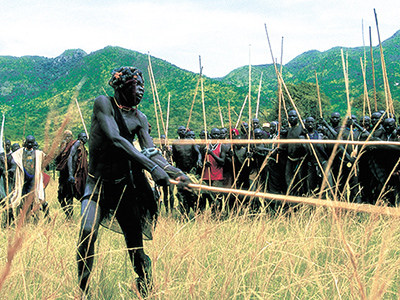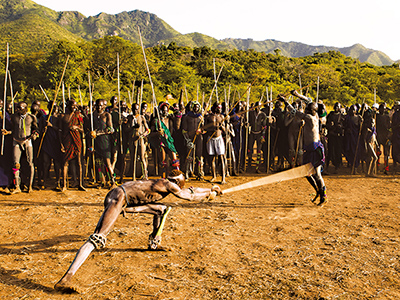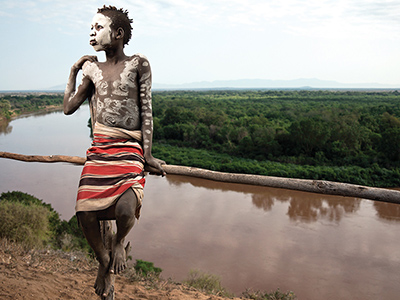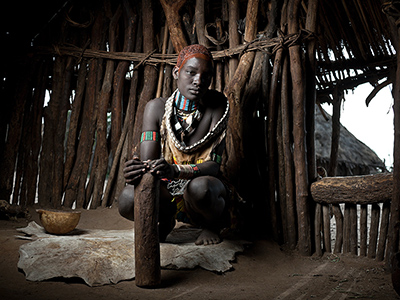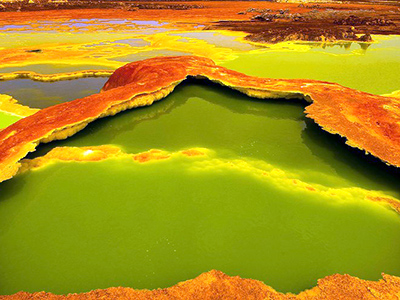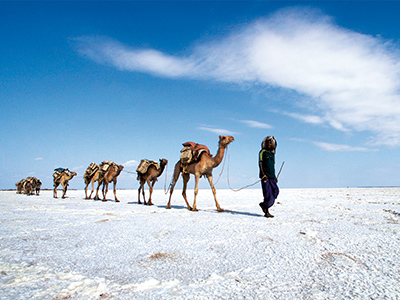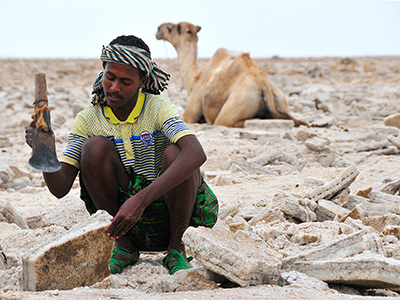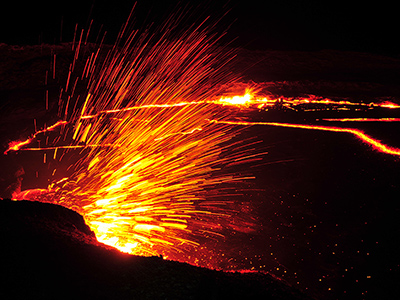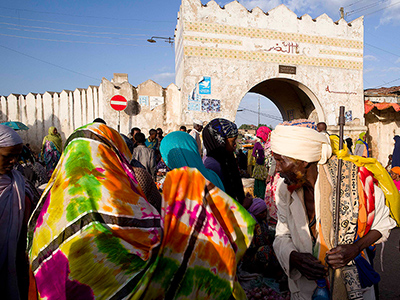Christian art:
Ethiopia has developed a deep religious tradition as well as a distinctive form of Christian art. Its three chief forms are architecture, metalwork and painting. Christian architecture is to some extend influenced by the Aksumite civilisation; the first rock hewn monuments date back to the 7th century. They first appear in the Tigray province, where a large cross-shaped funeral church has been carved out, dedicated to its rulers - the twin brothers Abreha and Atsbeha. The Lalibela church ensemble remains the most famous one. King Lalibela had the first monolith churches made in the 12th century. When they are not carved into the rock, Ethiopian churches are often octogonal. They are frequently ornamented inside and it is mostly from this form of art that Ethiopian painting has evolved, influenced by Byzantine art. The country’s isolation from the rest of the world is made particularly evident in the paintings from the 12th to the 15th centuries, when a true Ethiopian style has emerged. The first original Ethiopian pictorial school appears around 1400, while painters are mainly illustrating manuscripts. Besides architecture and painting, one of the most original art in Ethiopian Christian art is the cross art.
Crafts:
Textiles, pottery, jewellery and leather are products emblematic for Ethiopian culture and lifestyle. One can however note some regional peculiarities, as is the case with the Kaffa region where the existing regional coffee culture has enabled the development of a coffee-centered craft focused around clay coffee cups and coffee pots.
The headrest is an important object in Ethiopian craft: widespread on the south, it is often dugout, but can sometimes be formed of two pieces. The extraordinarily diverse Ethiopian pottery is of great quality, especially in the regions of Tigray, Harar, Illubabor and Wolayita…
Crafts testify of the local artists’ thousands years old ingenuity and know-how, as well as of the country’s cultural diversity. Crafts are representative of talents and traditions pertaining to different ethnies’ ornamentation. For example, the most popular items of the Harari craft are their colourful baskets, such as the mesob basket - a kind of circular table-basket designed for serving injera, as well as their jewellery - both widespread in the whole Horn of Africa. Wool weaving is not any less emblematic and it is the speciality of the Konso people, while the Dorze people specialise in cotton weaving. These ethnies provide a crucial part of the traditional clothing demand. Equally gifted weavers, the Gurges are renown for their working of the horn, from which they create spoons, cups and combs. The Arsi decorative adornments made from colourful beads and worn as necklaces, diadem or earrings are popular in the whole country. The Jimma region, with its extensive forest ressources, produces impressive wooden chairs carved from a single piece of wood as well as the very popular three-legged stools. Finally, the pastoralist communities produce many containers executed in mixed techniques and using different materials (gourd, wood, leather…), often ornamented with beads. All of these flasks, milk jugs, butter dishes as well as the traditional “agelgil” (little leather-covered basket used for transporting food) are most decorative in their simplicity.
Music:
Ethiopian music is extremely diverse as each of the 80 ethnies of the country has its own particularities. Numerous influences include Christian and Muslim liturgy as well as pop music from the Horn of Africa countries - Somaly and Sudanese in particular. Ethiopian music often recurs to a unique, pentatonic modal system, characterised by prolonged intervals between some notes. The whole Orthodox liturgy is chanted and religious music remains an essential subject in religious education.
In the 1960’s, in the bars of Addis Ababa, the traditional Azmari music gains some exterior influences and merges with blues and jazz, giving birth to a unique current in the history of African music - Ethio Jazz. Amongst its most famous representatives in the 1970’s there were Mahmoud Ahmed - who to this day remains the Ethiopian singer the most popular abroad, and Mulatu Astake - considered the real father of ethio jazz. The saxophonist Getachew Mekurya and the singer Alemayehu Eshete are two other illustrious emblematic figures of this genre. Towards the end of the 1990’s, the french record label Buda Music has reedited the greatest voices of ethio-jazz in the Ethiopiques collection allowing the western world to rediscover the groove from the Horn of Africa. Aster Aweke is a star female singer to which we owe a savant combination of traditional sonorities and pop music. Among the new generation - Teddy Afro is currently the most popular artist in Ethiopia.
Sports:
There are two major sport disciplines in Ethiopia: running and football. Long-distance and middle-distance track remain the main passions of all nations accustomed to see their athletes in a blaze of glory during major international competitions. These athletes are certainly the ones who enjoy the most consensual reputation countrywide. Having earned international renown through the media coverage of major sporting events, they are probably the most famous Ethiopians outside the country’s borders. Amongst Ethiopians having dominated long-distance running competitions worldwide, in the last years the most notable are Haile Gebrselassie, world champion and Olympic champion who has established over twenty new world records. Kenenisa Bekele is another major figure - world champion in long-distance running and double Olympic champion in Beijing. He also remains, since 2010, the current Olympic record holder in both the 5,000 metre and 10,000 metre events. When it comes to women competitions, the Beijing Olympic female champion Tirunesh Dibaba is the current record holder for the 5,000 metre event. As many other Ethiopian runners have made a strong impression in this discipline, it is also worth to mention Abebe Bikila - the first African gold medalist who won the marathon at the 1960 Summer Olympics in Rome while running barefoot, Mamo Wolde, Miruts Yifter, Derartu Tulu, Gebregziabher Gebremariam and Million Wolde. Derartu Tulu was the first African woman to win gold at the 1992 Olympics in Barcelona in the 10,000 metre.
Ethiopia is also very fond of football. Sadly, and much to the despair of local football fans, the Ethiopian national team’s performance is quite poor - even considered at a continental level. Nevertheless, football remains a very popular sport in Ethiopia, even if Ethiopia’s national team is not very successful. At an international level Ethiopia ended up 123rd in the FIFA World Ranking in 2010 and it has never managed to qualify for the World Cup. Nowadays Ethiopians are most interested in the English Premier League, which is largely retransmitted on the country’s television channels. Young people are eager to cheer for Manchester, Arsenal, Barcelona or Real Madrid...

![Map of Ethiopia - By CIA [Public domain], via Wikimedia Commons](img/gallery/decouvrir/map.jpg)















